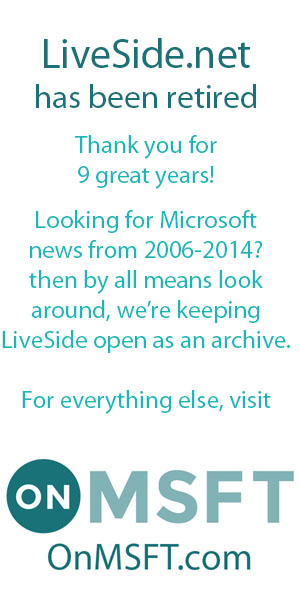 Another day, another report of how the new, post Ballmer Microsoft is speeding up its cadence on delivering Windows, this time with Mary Jo Foley reporting that there may be another update to Windows 8.1 as early as this August. This “new” Microsoft, it seems, is ready to deliver updates to Windows and Windows Phone at blinding speeds, unlike the plodding Windows teams of old, and that speed is being taken as a sign that new CEO Satya Nadella is ready to drive the company faster than it’s ever moved before.
Another day, another report of how the new, post Ballmer Microsoft is speeding up its cadence on delivering Windows, this time with Mary Jo Foley reporting that there may be another update to Windows 8.1 as early as this August. This “new” Microsoft, it seems, is ready to deliver updates to Windows and Windows Phone at blinding speeds, unlike the plodding Windows teams of old, and that speed is being taken as a sign that new CEO Satya Nadella is ready to drive the company faster than it’s ever moved before.
And that may all be true for Windows, which in some respects may be the one product line coming out of Redmond that doesn’t need to move faster. Almost 30% of the world’s computers are still happily running XP, and uptake on Windows 8.x has been slow, and unless this new faster cadence is used to “fix” Windows 8 (which in some respects is exactly what it’s doing, moving Windows 8 more and more back to the desktop model of Windows 7, as Microsoft’s bet on its “Modern” interface fails to take hold), the world isn’t exactly holding its breath for a new version of Windows every 9 months.
The problem is that even with this new faster cadence, so far it’s only coming for Windows, and Microsoft remains stuck in the mud a number of other areas and product lines. For all the hoopla surrounding the name change from SkyDrive to OneDrive, the fact is that service hasn’t seen a significant feature upgrade in well over a year. The “Modern” apps that shipped with Windows (Mail, Calendar, Photos, etc.) remain crippled versions of their Windows Live counterparts, and again haven’t seen any significant movement since the middle of last year. The Mail app that shipped with Windows Phone 8.1, while granted is still in its beta stages, is actually even LESS functional than the Windows Phone mail app we have now, which is hard to do.
Then there’s Skype, which faces even bigger problems. Aside from its lack of feature parity with Windows Live Messenger, at its core Skype is old technology. Rooted in the desktop, with no clear path to compete in an increasingly mobile first world, Skype is going to be hard pressed to compete with a truly mobile first WhatsApp, especially with the power of Facebook behind it. It also seems to be rooted in “old Microsoft”, with upgrades coming few and far between. Sure, like OneDrive, there’s lots of marketing fluff, but real engineering innovations? Not so much.
In other areas, Microsoft is showing signs of coming out of its malaise, but still remains far behind. Azure, especially under the tutelage of Scott Guthrie, seems to implement a full slate of new features every few months, but still remains far behind industry leading Amazon. So much so that a recent post over at NextGov, an “information resource for federal technology decision makers“, on the “battle” between Amazon and Google for the cloud, Microsoft isn’t even mentioned until the very end.
Microsoft’s biggest challenge may well be coming starting as early as this Friday, when it seeks to assimilate some 30,000 new workers and a whole new way of doing business with the acquisition (after an already slow start, who knew) of Nokia’s phones businesses. Microsoft’s track record in bringing acquired companies into the fold hasn’t been stellar. In 2000, Microsoft acquired Bungie to build out Xbox games, which it did with the Halo franchise but ended up splitting from the company in 2007, a marriage that financial analyst Roger Ehrenberg at the time called “doomed to fail“. In 2008, it acquired Danger, maker of the TMobile Sidekick, and used those resources to produce one of Microsoft’s biggest flops ever, the KIN. In 2012, the company wrote off its $6 billion acquisition in 2007 of AQuantive, squandering a once promising company by using it to chase after Google’s industry leading advertising businesses, a familiar refrain to those who have doubts about the wisdom of Microsoft’s Nokia acquisition.
So while everyone oohs and ahhs at Microsoft’s newfound “speed of innovation”, we’ve yet to see it filter down to where it really matters, transforming a platform and “Hello World” app demo company into one that’s consistently and quickly producing best in class apps, and innovative hardware. Not that there aren’t some good signs – Office seems to be embracing this brave new world with Office for iPad, although that took three years to produce, and there’s still not much more than vaporware to show for a Windows version of a touch first Modern Office. The “Bing” apps have shown promise, too.
Can Microsoft transform itself into a lean, mean, app making machine? Can it absorb Nokia without screwing things up? Does a faster moving Windows division even really matter all that much, or does Microsoft need to innovate in new ways with new products and a newfound culture we’ve yet to see? These next few months will put Satya Nadella and the newly configured Board of Directors to the test, but it’s going to take more than a 9 month Windows product cycle to move Microsoft forward.

